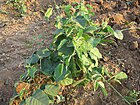Note: This is a project under development. The articles on this wiki are just being initiated and broadly incomplete. You can Help creating new pages.
Difference between revisions of "Leptadenia reticulata - Swarna Jeevanti"
(→References) |
|||
| Line 66: | Line 66: | ||
==Photo Gallery== | ==Photo Gallery== | ||
<gallery class="left" caption="" widths="140px" heights="140px"> | <gallery class="left" caption="" widths="140px" heights="140px"> | ||
| − | File:Leptadenia reticulata climber.JPG | + | File:Leptadenia reticulata climber.JPG|Plant |
</gallery> | </gallery> | ||
Revision as of 09:26, 29 May 2020
Leptadenia Reticulata is a Botanical name of Jeevani in Sanskrit.
Contents
- 1 Uses
- 2 Parts Used
- 3 Chemical Composition
- 4 Common names
- 5 Properties
- 6 Habit
- 7 Identification
- 8 List of Ayurvedic medicine in which the herb is used
- 9 Where to get the saplings
- 10 Mode of Propagation
- 11 How to plant/cultivate
- 12 Commonly seen growing in areas
- 13 Photo Gallery
- 14 References
- 15 External Links
Uses
Skin diseases, Wounds, Allergies, Inflammation of the skin, Chest congestion, Cough, Cold, Blood pressure, Gangrene, Diarrhea, Bleeding wounds, Cuts.
Parts Used
Chemical Composition
Ferulic acid, luteolin, diosmetin, rutin, β-sitosterol, stigmasterol, hentricontanol, a triterpene alcohol simiarenol, apigenin, reticulin, deniculatin, and leptaculatin[1]
Common names
| Language | Common name |
|---|---|
| Kannada | Hiriyahalle |
| Hindi | Dori |
| Malayalam | |
| Tamil | Palaikkodi |
| Telugu | Kalasa |
| Marathi | NA |
| Gujarathi | NA |
| Punjabi | NA |
| Kashmiri | NA |
| Sanskrit | Jivanti, Jivaniya |
| English | Leptadenia |
Properties
Reference: Dravya - Substance, Rasa - Taste, Guna - Qualities, Veerya - Potency, Vipaka - Post-digesion effect, Karma - Pharmacological activity, Prabhava - Therepeutics.
Dravya
Rasa
Madhura (Sweet)
Guna
Laghu (Light), Snigda (heavy)
Veerya
Sheeta (cold)
Vipaka
Madhura (Sweet)
Karma
Vata, Pitta
Prabhava
Habit
Identification
Leaf
| Kind | Shape | Feature |
|---|---|---|
| Simple | ovate | The leaves are ovate to cordate, 4 to 7.5 cm long, 2 to 5 cm and petiole 1 to 3 cm long |
Flower
| Type | Size | Color and composition | Stamen | More information |
|---|---|---|---|---|
| Unisexual | 2-4cm long | greenish yellow | 5-20 | Flowering occurs in May and June |
Fruit
| Type | Size | Mass | Appearance | Seeds | More information |
|---|---|---|---|---|---|
| simple | 8–10 mm | fruiting begins in October and continues up to November | With hooked hairs | {{{6}}} |
Other features
List of Ayurvedic medicine in which the herb is used
- Anu taila
- Jeevantyadi ghrita
- Chyavanprash
- Ashwagandhadi churna
- Brihat chagalyadi ghrita
- Sukumaram kashaya churna
Where to get the saplings
Mode of Propagation
How to plant/cultivate
This plant grows in arid regions, which are characterized by sandy soil, low organic matter, and rainfall deficit. Rooted semi-wooded stem cuttings from six-month-old to one-year-old plants having three to four nodes at pre flowering stage are generally used for planting. Seeds may also be collected in November for raising the plants. [4]
Commonly seen growing in areas
Sandy loamy-clay soil, Meadows, Borders of forests and fields.
Photo Gallery
References
External Links
- Ayurvedic Herbs known to be helpful to treat Skin diseases
- Ayurvedic Herbs known to be helpful to treat Wounds
- Ayurvedic Herbs known to be helpful to treat Allergies
- Ayurvedic Herbs known to be helpful to treat Inflammation of the skin
- Ayurvedic Herbs known to be helpful to treat Chest congestion
- Ayurvedic Herbs known to be helpful to treat Cough
- Ayurvedic Herbs known to be helpful to treat Cold
- Ayurvedic Herbs known to be helpful to treat Blood pressure
- Ayurvedic Herbs known to be helpful to treat Gangrene
- Ayurvedic Herbs known to be helpful to treat Diarrhea
- Ayurvedic Herbs known to be helpful to treat Bleeding wounds
- Ayurvedic Herbs known to be helpful to treat Cuts
- Herbs with Leaves used in medicine
- Herbs with Roots used in medicine
- Herbs with Stem used in medicine
- Herbs with common name in Kannada
- Herbs with common name in Hindi
- Herbs with common name in Tamil
- Herbs with common name in Telugu
- Herbs with common name in Sanskrit
- Herbs with common name in English
- Habit - Herb
- Index of Plants which can be propagated by Seeds
- Index of Plants which can be propagated by Cuttings
- Herbs that are commonly seen in the region of Sandy loamy-clay soil
- Herbs that are commonly seen in the region of Meadows
- Herbs that are commonly seen in the region of Borders of forests and fields
- Herbs
- Ayurvedic herbs that don't have flower, fruit and leaf photos
- Ayurvedic herbs that don't have seed photos
- Apocynaceae

